Algarve-Tourist.com
The best independent guide to Portimão
Algarve-Tourist.com
The best independent guide to Portimão
Portimão: Sights, Attractions and Things to See and Do in 2026
Beyond the glittering beaches and resort developments of the Algarve lies Portimão, a genuine Portuguese city where authentic local life thrives alongside historical landmarks and modern attractions. As the region's second-largest city and former sardine capital, Portimão offers visitors something increasingly rare in the Algarve: a destination that balances tourism with real Portuguese character.
The city's fascinating evolution from humble fishing village to industrial powerhouse tells the story of Portuguese ingenuity and maritime mastery. Walking through Portimão's historic quarter, you'll discover centuries-old churches, traditional markets, and a museum that brings the sardine canning era to life.
The revitalized riverfront along the Arade River provides a scenic backdrop for excellent seafood restaurants, while the bustling marina serves as the departure point for boat tours to the legendary Benagil Cave.
Related articles: Portimão beach guide
Overview of the Major Sights of Portimão
Here is an overview of all the major sights you should experience during your visit to Portimão.
Museu de Portimão - The award-winning museum housed in a beautifully restored 19th-century sardine canning factory tells the fascinating story of the industry that built modern Portimão. This interactive museum brings the city's maritime and industrial heritage to life.
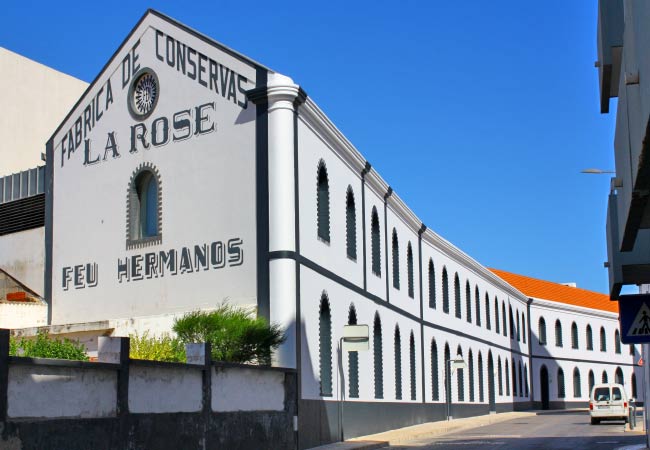
Portimão Marina – A sheltered Maria on the mouth of the Arade River and serves as the departure point for boat tours along the spectacular Algarve coastline. The modern marina complex offers waterfront dining, shopping, and stunning views across the Arade River to the picturesque fishing village of Ferragudo.
Igreja do Colégio - Portimão's grandest church dominates the main square with its impressive 17th-century Baroque façade. Funded by a wealthy merchant who made his fortune in the Orient, this former Jesuit college features the largest church interior in the Algarve.
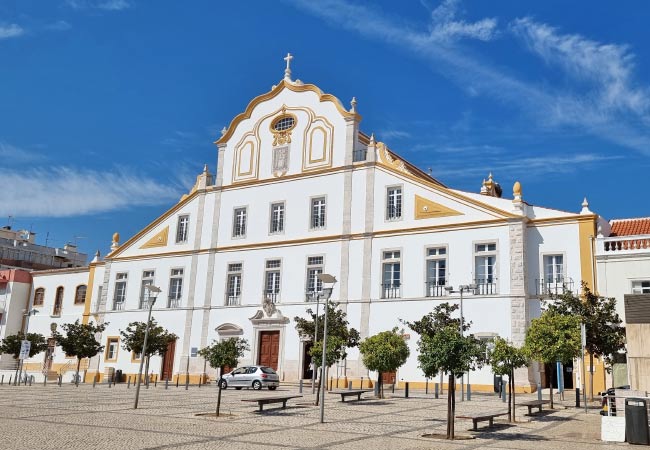
Igreja de Nossa Senhora da Conceição - The Mother Church of Portimão showcases a beautiful Gothic portal, the sole survivor of the original 15th-century structure that withstood the devastating 1755 earthquake.
Ribeirinha de Portimão - The scenic riverfront promenade along the Arade River which once had fishing docks and warehouse. The pretty 1km walk provides palm-lined walkways, outdoor dining options, and peaceful views of traditional fishing boats alongside luxury yachts.
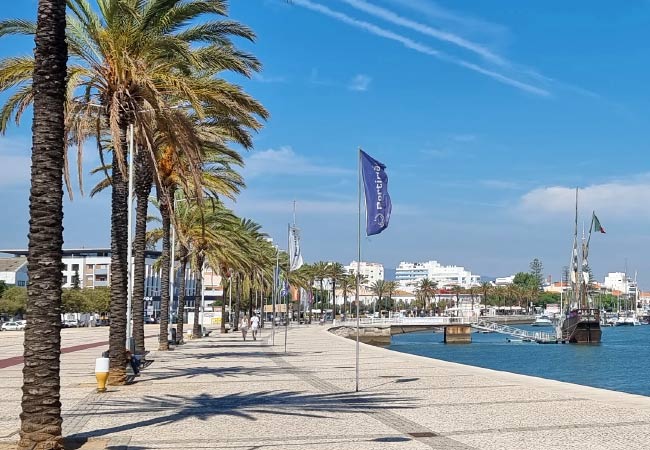
Municipal Market - The bustling Mercado Municipal offers an authentic glimpse into Portuguese daily life, with local vendors selling the freshest catch of the day alongside regional produce and traditional handicrafts.
Historic Quarter - Wander through pedestrianised streets lined with traditional Portuguese architecture, discover hidden squares with orange trees, and explore local shops selling everything from handmade ceramics to regional wines.
Zona Ribeirinha - The old fishing dock area, particularly around 'Doca da Sardinha' (Sardine Dock), features authentic restaurants serving grilled sardines and fresh seafood in rustic settings with river views.
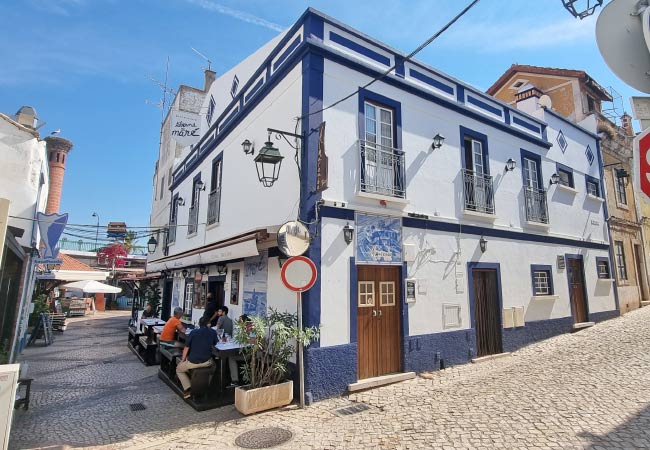
Sights of the Portimão Region
Portimão is surrounded by many interesting sights and towns and some of the best which should be included in your holiday are:
Ferragudo (3km) - Just a short ferry ride across the Arade River (or a 10-minute drive if you prefer), this gorgeous fishing village feels like stepping back in time. Cobbled streets wind up from the harbour past whitewashed houses to a lovely church square, while down at the waterfront you can watch fishermen sorting their catch
Alvor (7km) - About 15 minutes west of Portimão, Alvor manages to be both authentic and visitor-friendly. The fishing boats still come and go from the harbour, elderly locals chat in the main square, and the restaurants serve whatever was caught that morning. The beach stretches for miles, and if you're lucky you might spot flamingos in the nature reserve behind the village.
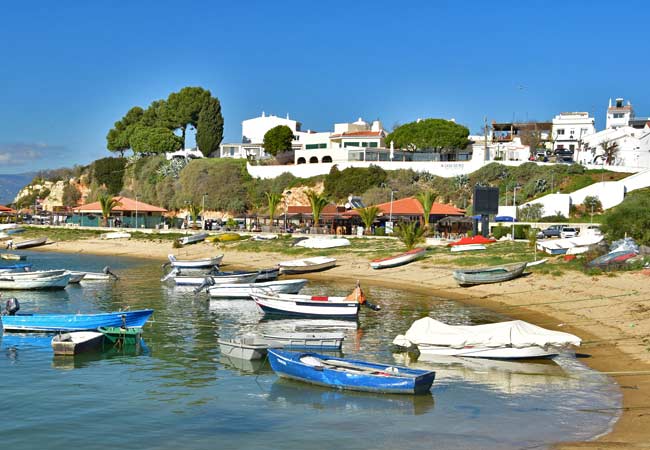
Benagil Cave (15km) - This famous sea cave near Carvoeiro features a natural hole in its roof that allows sunlight to illuminate the sandy beach inside. Boat tours from Portimão Marina provide the most popular way to visit this much-photographed cave, which has become one of the Algarve's most sought-after attractions.
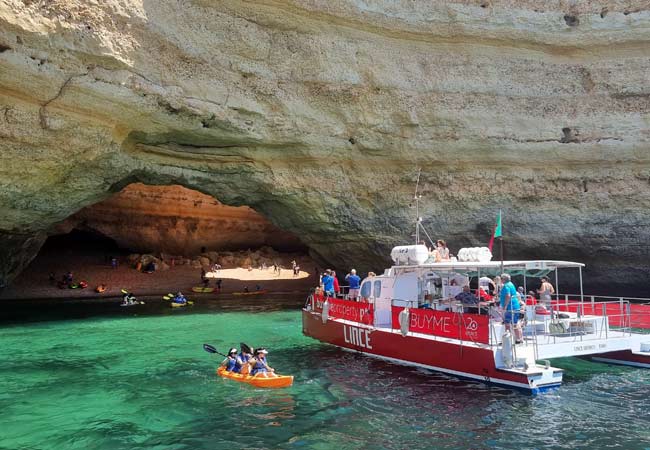
Silves (25km) - Once the Moorish capital of the Algarve, and you can still feel that history today. The red sandstone castle dominates the skyline and offers fantastic views, while the old town below maintains an authentic Portuguese atmosphere often missing from coastal resorts. During summer, you can actually take a boat trip up the Arade River from Portimão - a lovely way to arrive and see the countryside from a different perspective.
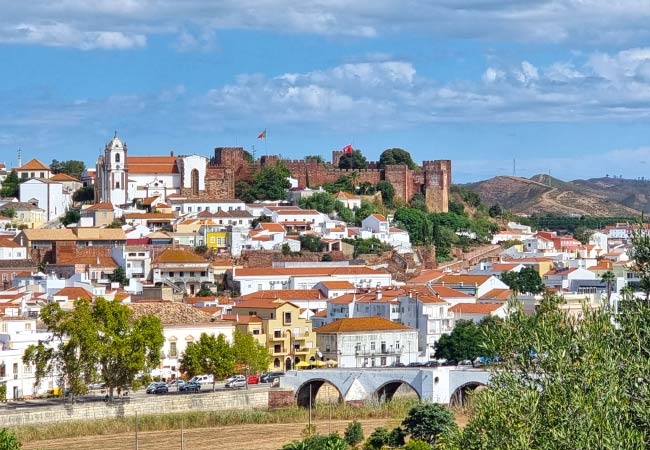
Algar Seco (12km) - These extraordinary rock formations near Carvoeiro look like something from another planet. The limestone has been carved by wind and waves into natural sculptures, arches, and viewing platforms.
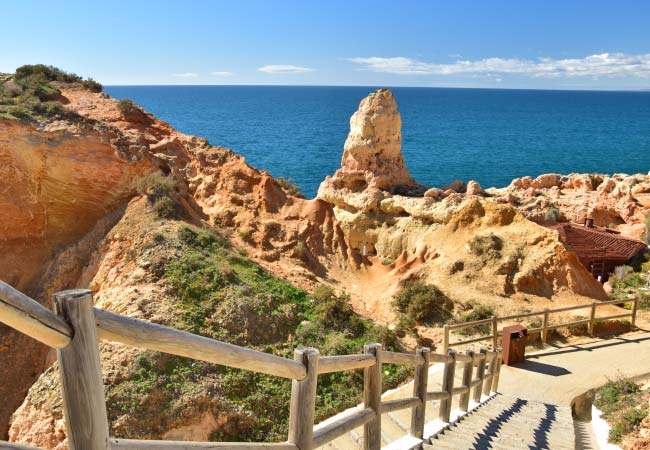
Wine tasting – Explore beautiful vineyards within the region offering tastings and estate tours, including Quinta dos Vales and Morgado do Quintão. Sample award-winning local wines and learn about traditional wine-making methods in picturesque settings.

Vale Suspenso Hiking Trail (17km) - This spectacular clifftop trail between Carvoeiro and Praia da Marinha offers some of the Algarve's most dramatic coastal scenery. The 6km path follows the edge of golden limestone cliffs, providing panoramic ocean views and access to hidden viewpoints overlooking secluded coves below.
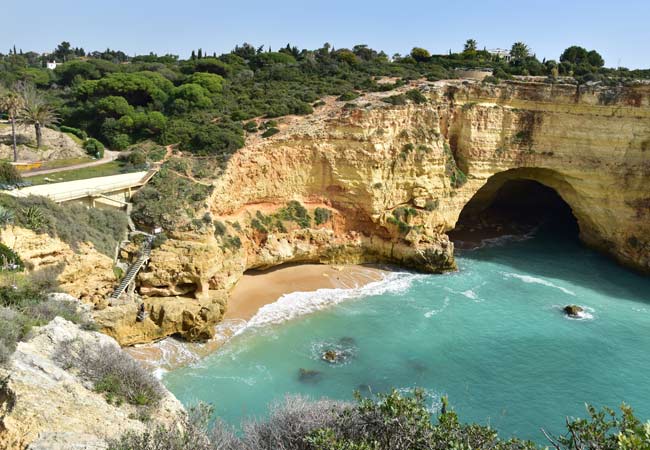
Zoomarine (20km) - The Algarve's best theme park delivers an impressive mix of marine life shows, water attractions and wildlife encounters. The dolphin presentations remain the star attraction, cleverly combining spectacular acrobatics with conservation education, while the sea lion shows guarantee laughs from all ages.
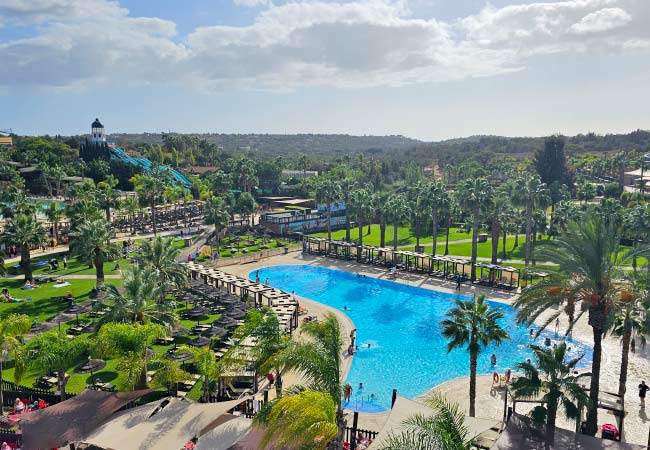
Slide & Splash (15km) - The Algarve's premier water park spans over 16,000 square metres in Lagoa, featuring an impressive array of water attractions for all ages. Adrenaline-seekers can experience the heart-stopping Kamikaze slide, the spiralling Black Hole, and the massive Big Wave, while gentler attractions cater to families and younger visitors.

Praia da Marinha (18km) - Consistently rated among Europe's finest beaches, this spectacular cove near Carvoeiro showcases the Algarve's coastal beauty at its most pristine. Golden sand nestles between towering limestone cliffs carved into dramatic arches and formations, while crystal-clear turquoise waters provide excellent swimming and snorkelling conditions
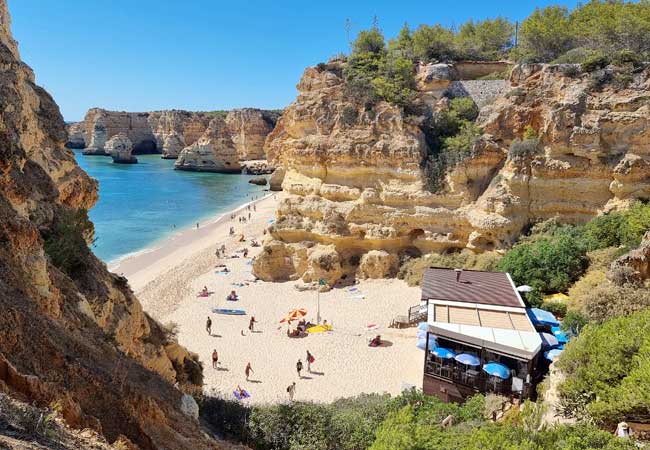
Autódromo Internacional do Algarve (15km) - Portugal's Formula 1 circuit offers driving experiences, karting, and motorsport events throughout the year. Visitors can experience the challenging "Rollercoaster" track that has hosted international racing series, with options ranging from passenger rides to full racing experiences.
Map of Portimão and Praia da Rocha Sights
The following map details the location of all major sights in Portimão and Praia da Rocha covered in this guide. Note: zoom in or out to see all points of interest.
Legend: 1) Museu de Portimão 2) Igreja do Colégio 3) Portimão Marina 4) Igreja de Nossa Senhora da Conceição 5) Ribeirinha de Portimão 6) Municipal Market (Mercado Municipal) 7) Historic Quarter 8) Zona Ribeirinha 9) Ferragudo 10) Alvor 11) Benagil Cave 12) Silves 13) Algar Seco 14) Vale Suspenso Hiking Trail 15) Zoomarine 16) Slide & Splash 17) Praia da Marinha 18) Autódromo Internacional do Algarve
Beaches: 18) Praia da Rocha 19) Praia dos Três Castelos 20) Praia do Vau 21) Praia Grande 22) Praia dos Caneiros 23) Praia de Alvor
Detailed Description of the Sights of Portimão
Three kilometres south of Portimão centre, where the Arade River meets the Atlantic, Praia da Rocha has grown from a small fishing settlement into the Algarve's most famous beach resort. Though technically part of Portimão, it feels like its own town with distinct neighbourhoods, year-round residents, and a character that shifts dramatically with the seasons.
The beach stretches for nearly 2km between dramatic golden cliffs that glow golden in the afternoon sun. These weathered rock formations, carved into arches, stacks and caves by Atlantic storms, give the beach its name and create the postcard views that first attracted wealthy Portuguese holidaymakers in the 1930s. Today only the Casino and a handful of original buildings survive, dwarfed by the concrete towers that sprouted during the 1980s tourism boom.
The clifftop Avenida Tomás Cabreira provides the beach's social heartbeat. By day it's perfect for strolling, with wooden walkways weaving between the rock formations and miradouros (viewpoints). Come evening, the avenue transforms into the Algarve's liveliest strip. Irish pubs compete with cocktail bars, restaurants serve everything from fresh grilled fish to full English breakfasts, and by midnight the younger crowd spills between venues that pump music until dawn.
Museu de Portimão
This award-winning museum housed in a beautifully restored sardine canning factory brings Portimão's industrial past to life in fascinating detail. The La Rosé factory operated here from 1889 to the 1970s, and walking through its preserved production lines feels like stepping back to when sardines were the town's silver gold.
The museum includes actual factory floor with its original machinery, including the "beheading room" where thousands of fish were processed daily. The authentic 1950s production line remains intact, complete with the conveyor belts, cooking vats, and tin-making equipment that employed hundreds of local families.
Beyond the industrial heritage, the museum surprises with its archaeological collection spanning 5,000 years. Roman fish-salting tanks, Islamic ceramics, and prehistoric tools tell the longer story of human settlement along the Arade River.
Practical Information: Open Tuesday-Sunday (closed Mondays), Admission: €3 (free for under-12s)
Forte de Santa Catarina
Sitting on the eastern headland of Praia da Rocha, this compact 17th-century fortress commands the best views in Portimão. It was built between 1621 and 1633 to guard the Arade River entrance from pirates and foreign raiders. Military architect Alexandre Massai chose this spot not just for its commanding position but also for a freshwater spring - crucial for withstanding sieges that thankfully never came.
Inside the modest fortification, the small chapel dedicated to Saint Catherine predates the military structure and still maintains its contemplative atmosphere. The real draw, though, is climbing to the ramparts.
Igreja do Colégio
The Convento do Colégio dos Jesuítas (Igreja da Misericórdia) in Praça da República, is in the very center of Portimão. The church dates from 1660, though it was not consecrated until as late as 1707. This represents one of the finest examples of Jesuit architecture in the Algarve region.
Funds were provided for its construction by D. Diogo Gonçalves, a businessman who had made his money in the Orient, on the proviso that he should be buried inside. The church stands as a insight into the vast wealth generated by Portuguese maritime commerce during the Age of Discovery.
The imposing main façade is the work of João Nunes Tinoco, a prestigious figure in Portuguese architecture of the second half of the seventeenth century. The church has a single nave with high barrel vaulting. The interior reflects the austere aesthetic of the Jesuits, though later Baroque additions include beautiful gilt carved woodwork.
The church dominates Praça da República, Portimão's main square, creating an impressive architectural focal point for the historic city center. As with so many other churches in the Algarve, the Baroque Igreja do Colégio was badly damaged in the 1755 earthquake.
Benagil Cave Boat Tours
Boat tours to the famous Benagil Cave depart regularly from Portimão Marina, offering the most convenient way to explore the Algarve's spectacular coastline. The 2-2.5 hour round trip covers approximately 20km of dramatic cliffs, visiting multiple sea caves and hidden beaches inaccessible by land.
The highlight is undoubtedly Benagil Cave itself, a collapsed sea cave with a circular opening in its roof that creates a natural spotlight effect on the small beach inside.
Most tours also include stops at other notable caves between Portimão and Benagil, including the Cathedral Cave, Elephant Cave, and several smaller grottoes around Algar Seco. Boats pass close to the picturesque village of Ferragudo, and often pause at Marinha Beach or Praia da Corredoura where passengers can swim from the boat in crystal-clear waters
Tour options range from small RIB speedboats (12 passengers) that can enter smaller caves to larger catamarans (50+ passengers) offering more stability and shade. Prices typically run €20-35 per person depending on boat size and season.
Morning tours often encounter calmer seas, while afternoon trips may face choppier conditions. Book ahead in July-August when tours fill quickly, especially the popular sunset cruises
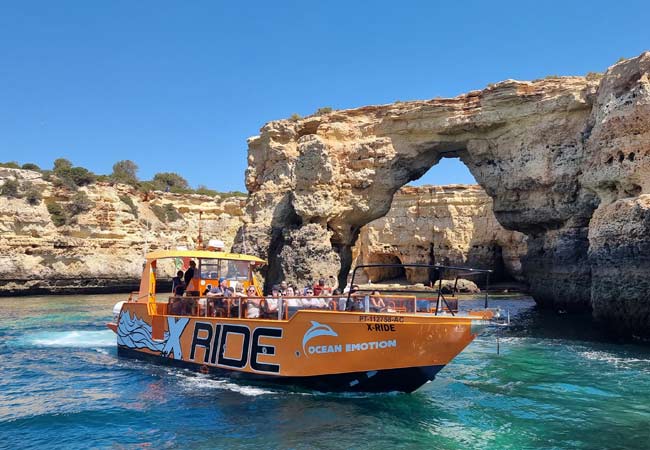
Ferragudo
This working fishing village sits directly across the Arade River from Portimão Marina - just 5 minutes by ferry (€1.50) or a 10-minute drive via the bridge. Unlike many prettified Algarve villages, Ferragudo remains a genuine fishing port where locals outnumber tourists and the boats in the harbour actually catch fish rather than carry sightseers.
The village climbs steeply from the waterfront to the Igreja de Nossa Senhora da Conceição, with narrow cobbled streets that are genuinely medieval rather than tourist-board recreations. The main square by the church provides the village social centre, with two good cafés and views across to Portimão.
Ferragudo has two distinct areas: the old village and Praia Grande, a modern development around the magnificent beach of the same name.
Alvor
This delightful fishing village has managed to retain its authentic Portuguese character despite its proximity to the larger resort towns. Sitting along around a picturesque estuary where the Alvor River meets the Atlantic, the town centres on its working harbour where colourful fishing boats still bring in the daily catch.
The village's narrow cobbled streets wind between traditional whitewashed houses adorned with terracotta roofs and decorative chimneys, creating an atmosphere that feels genuinely Portuguese rather than purpose-built for tourism. The heart of Alvor remains its charming main square, where locals gather at outdoor cafés and the 16th-century parish church provides a focal point for community life.
Alvor's greatest asset is its magnificent beach, a vast expanse of golden sand stretching for over 3 kilometres, backed by low dunes rather than dramatic cliffs.
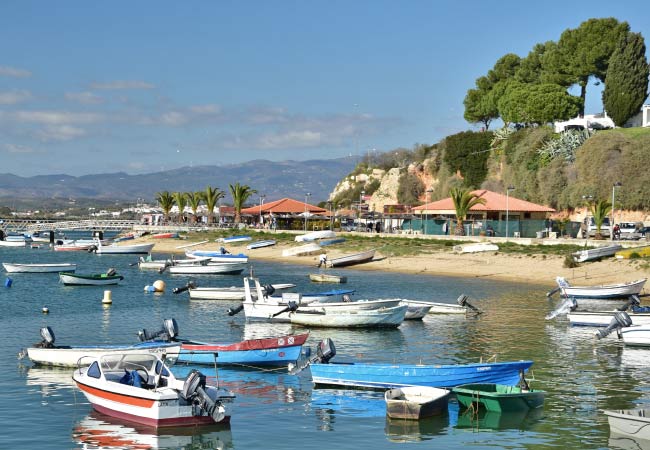
Autódromo Internacional do Algarve
Portugal's premier motorsport facility, known internationally as Portimão Circuit, provides an exhilarating destination for racing enthusiasts and adrenaline seekers. This challenging track, nicknamed "The Rollercoaster" for its dramatic elevation changes and flowing corners, has hosted Formula 1, MotoGP, and numerous international racing series since opening in 2008.
The track rises and falls through 15 challenging corners across 4.6 kilometers, providing technical challenges that have impressed professional drivers worldwide. For visitors, the facility offers various driving experiences throughout the year, from passenger rides in high-performance vehicles to full racing experiences where you can tackle the same corners navigated by Formula 1 champions.
The karting track provides an accessible introduction to motorsport for families and younger visitors. This professionally designed circuit mirrors many characteristics of the main track while remaining suitable for drivers aged 8 and above.
Silves
Once the magnificent capital of Moorish Algarve, Silves tells the story of Portugal's complex cultural heritage through its preserved medieval architecture and genuine local character.
The imposing Castelo de Silves dominates the skyline, its red sandstone walls rising dramatically above the surrounding countryside. Built by Moorish rulers in the 11th century and later expanded by Christian forces. Walking the ramparts, you can trace the outline of the ancient town below while gazing across olive groves and orange orchards toward the distant coast.
The Gothic Sé Cathedral, constructed on the site of the former great mosque, show the architectural transition from Islamic to Christian rule. Its austere exterior conceals remarkable treasures, including medieval tombs of crusader knights and beautiful carved stone details that survived centuries of earthquakes and renovations.
Silves' old town unfolds in a maze of narrow cobbled streets lined with traditional houses, small squares shaded by orange trees, and genuine Portuguese businesses serving locals rather than tourists. The municipal market offers insight into daily life, while family-run restaurants serve regional specialties in settings that have welcomed guests for generations.
Algar Seco
These extraordinary limestone formations near Carvoeiro create one of the Algarve's most otherworldly landscapes. Wind and waves have sculpted the golden cliffs into natural architecture that seems almost deliberately designed, with arches, chambers, and viewing platforms carved by millions of years of coastal erosion.
The name "Algar Seco" translates to "dry caves," referencing the numerous grottos and chambers accessible on foot during low tide. These natural sculptures take on an almost surreal quality, with smooth curves and dramatic openings that frame the Atlantic Ocean beyond.
The most famous formation is the natural viewing platform known as "Algar Seco Lookout," where erosion has created a perfect window overlooking hidden coves below.
Our most popular articles for Portimão and the Algarve
















